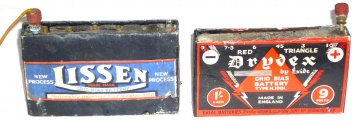Zinc carbon battery
Zinc carbon batteries are widely sold as low cost batteries. Life expectancy is the lowest of the popular battery types.
Performance
Terminal voltage is 1.5v. This voltage declines through the cell's useful life, and the cell is considered dead when its voltage reaches anything from 1.1v to 1.3v (dependant on application).
Current output and capacity per size are the lowest of all the popular battery chemistries. According to batteryshowdown the capaciy of ZnC AA cells is around 0.6Ah.
Leakage
Leakage is the main issue. The zinc case corrodes as part of normal operation, and if it corrodes through in one spot, corrosive leakage occurs. This is a good reason not to use these batteries in high value electronic goods.
Remove batteries if they will not be used for a fair length of time. Running them 100% flat increases the chance of leakage.
Metal damaged by corrosion, such as battery contacts, can be scraped to remove most of the corrosion. This usualy makes the appliance work again, but corroded circuit board tracks are usually corroded completely through by leakage, killing the appliance. Repair of corroded circuit board requires scraping, washing and soldering wires on to replace the lost tracks.
Zinc carbon batteries frequently have a clear plastic film wrap applied to help contain some leaks, don't remove it.
If a lumpy surface is seen under the plastic film, the zinc case has almost corroded through and is about to leak, and the battery should be disposed of.
One way to avoid damage from leakage and thus enable use of low cost batteries is to use an external battery holder, plugging it into the appliance. This works well enough with 9v types, which use a snap on genderless connector.
Shelf life
Shelf life is under 2 years. Life is maximised by keeping them in a cool place.
This doesn't mean all will be dead after 2 years. A batch of zinc carbon batteries from the early 90s was tested about 15 years later, and 3/4 of them were found to still be good for service.
The rate of chemical reactions is halved for each temperature drop of 10C, so fairly long term cold storage is possible, as long as measures are taken to keep the battery dry during storage and free of condensation during warm up. This method can be useful for rare battery types.
Rechargeability
The chemistry of zinc carbons is inherently non-chargeable, yet apparent recharging is obtained by putting them in a standard NiCd battery charger. Commercial products have occasionally reconditioned the batteries this way to extend battery life. How this works is beyond the scope of this article. Typically a battery can be cycled 2 or 3 times, with variable performance. However it significantly increases the risk of leakage.
Children have sometimes heated batteries to give extra time at end of life, but the resulting return is minimal.
How full
The amount of life left in a ZnC battery can be checked with a moving coil (old pointer type) ammeter. Set it to the 10A scale and apply the prods for a second at most. The higher the current reading, the more charge is left.
Note that D cells can deliver well over 10A, and for these a relative estimate of current and thus remaining charge is therefore made by noting the speed with which the pointer moves. When only applied for a second this is harmless.
Most digital meters are unable to do this test. The display takes too long to settle, and never does settle, since the current drawn doesn't remain steady. And an unsettled digital display is unreadable. The few digital meters that have sample and hold will work if they have a 30A scale (or higher); apply prods, take a sample and remove prods quickly.
Reuse
ZnC cells contain a central carbon rod. These can be used for miniature arc furnaces, iron carbon batteries, and various kids' projects.
